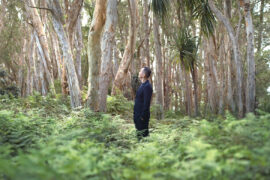“It’s the only way to go in our attempt to stave off climate change,” says architect and accredited leader in energy and environmental design, Nadine Samaha.

September 16th, 2021
Current Sustainability Awards winner Nadine Samaha is what many would describe as a force of nature. As a co-founder and senior principal architect for Level AK, a Lecturer at RMIT on Energy Efficient and Sustainable Design (ESD) and the Chair of the Australian Institute of Architects’ (AIA) Sustainable Architecture Forum, her career as an academic and architect has cemented her place as one of Australia’s foremost designers.
When outlining her first steps that initiated her journey as an architect, Samaha says it was the natural environment that ultimately led her down the path.
“I think from the beginning I was very much interested in landscape architecture and that’s how I effectively became an architect. All along, I was always interested in how to care for the environment,” she says.
A deep curiosity effectively inspired Samaha to take a LEED (Leadership in Energy and Environmental Design) exam, which gifted her with the title of LEED Green Associate.
“I took a LEED (exam) just for my own knowledge. I wanted to understand what was happening around the world in this space, in terms of what was going on in sustainable design,” she says.
“I completed the exam at a time when I was traveling to the UAE and the States, and I realized that globally, a lot of other people are relying on these particular credentials, as it teaches you all of the passive design principles. To keep your credential, you have to sit down every year and do around 15 hours of examination. It keeps you up to date with what’s happening within the industry.
“I always admired architects that utilise passive design principles. At the time when I was studying for the exam, I was able to connect with these types of architects through being the Chair of the Sustainable Architecture form, giving me the ability to speak with other like-minded people.”
An expert in regenerative design, Samaha believes that Australia’s built environment must look to adopt regenerative principles within its designs. Not typically seen within Australia, Samaha believes regenerative design is ‘the future’.
“Regenerative design means improving the immediate environment and giving back to nature. Sustainable architecture is mainly about balancing the scales, whereas if we adopt a regenerative approach we tip the scales in favour of the environment,” she says.
“Regenerative design is the future. It’s the only way to go in our attempt to stave off climate change. Architecture has to be driven by ecology and that is what regenerative design is at its core.
Being the Chair of the AIA’s Sustainable Architecture Forum, Samaha and her associates are able to shape the conversations around Australia’s built environment industry, as well as offering guidance to state and federal governments in regards to policies.
“We (the AIA’s Sustainable Design Forum) are very active at the moment. We provide a lot of advice, command and input for these advocacy and policies for both the AIA and the government,” she says.
“We’re currently trying to work closely with the government, sharing our knowledge in order to shape policies, such as the National Construction Code, with the NATHERS rating moving from 6 to 7 stars.
“But apart from working with the AIA’s policy and advocacy manager we run a number of events, including one with the Sustainable Living Festival.
“Our events are an opportunity to communicate everything about sustainability and regenerative design to the public, but to also share ideas among us as colleagues and academics.
Nadine’s practice, Level AK, recently devised a home located in Ceres that is completely off-grid. Dubbed Royd Clan’s House, the home’s volumes reference the existing boulders on site, with a number of sustainable materials utilised within the home, including prefabricated off-site CLT and Glulam renewable timber, 30kw Solar panels and a stored battery system, an 80,000 litre water tank and over 3500 native trees and flowers planted in order to rehabilitate soil and provide an income for the farm. The home also adaptively reuses a number of materials from the site.
INDESIGN is on instagram
Follow @indesignlive
A searchable and comprehensive guide for specifying leading products and their suppliers
Keep up to date with the latest and greatest from our industry BFF's!

The undeniable thread connecting Herman Miller and Knoll’s design legacies across the decades now finds its profound physical embodiment at MillerKnoll’s new Design Yard Archives.

London-based design duo Raw Edges have joined forces with Established & Sons and Tongue & Groove to introduce Wall to Wall – a hand-stained, “living collection” that transforms parquet flooring into a canvas of colour, pattern, and possibility.

For Aidan Mawhinney, the secret ingredient to Living Edge’s success “comes down to people, product and place.” As the brand celebrates a significant 25-year milestone, it’s that commitment to authentic, sustainable design – and the people behind it all – that continues to anchor its legacy.

Eco Outdoor recently brought together developers, sustainability experts and local architects such as Adam Haddow to discuss design fundamentals, carbon targets and long-term thinking.

In Naturalizing Architecture, Takada moves beyond biomimicry to propose a regenerative vision for the urban environment.
The internet never sleeps! Here's the stuff you might have missed

Bangalore studio Multitude of Sins elevates true leftovers — not surplus — into a richly layered workspace where waste materials become narrative, structure and sculptural expression.

It’s designed for how you live, not just for how it looks.